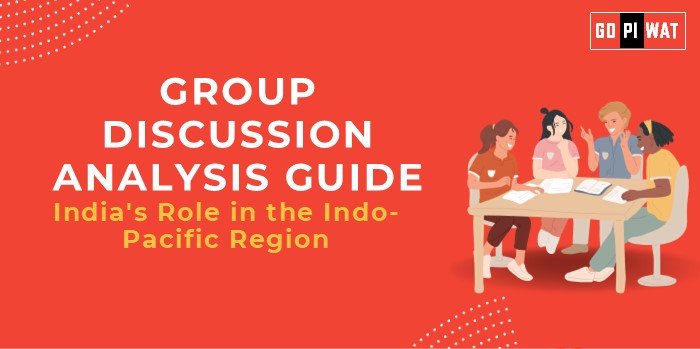📋 Group Discussion (GD) Analysis Guide
🌟 India’s Role in the Indo-Pacific Region
🌐 Introduction to the Topic
Opening Context: The Indo-Pacific region has emerged as a key area for global geopolitical and economic engagement. India’s growing role in this region, marked by its strategic alliances, economic initiatives, and defense capabilities, is increasingly being viewed as a stabilizing factor for global peace.
Topic Background: The Indo-Pacific concept gained prominence with the rise of China’s assertive policies, the U.S. pivot to Asia, and the introduction of the Quad (Quadrilateral Security Dialogue). India’s role, as a democracy with robust maritime interests and strong trade ties, is seen as pivotal in fostering balance and peace in the region.
📊 Quick Facts and Key Statistics
- 🚢 Maritime Trade Dependency: 95% of India’s trade by volume passes through Indo-Pacific waters, showcasing its critical economic stakes.
- ⚓ Defense Collaboration: India participates in over 20 maritime security exercises annually, including Malabar and RIMPAC.
- 🌏 Quad Partnership: Comprises India, the U.S., Japan, and Australia, advocating for a free and open Indo-Pacific.
- 💰 Economic Engagement: India’s Act East Policy emphasizes stronger economic ties with ASEAN, which collectively constitutes a $3 trillion economy.
👥 Stakeholders and Their Roles
- 🇮🇳 Government of India: Strategic maritime policies like SAGAR (Security and Growth for All in the Region).
- 🌐 Quad Nations: Coordinating for regional security and a rules-based order.
- 🌏 ASEAN Countries: Key trade and security partners for India.
- 🇨🇳 China: A major power influencing regional dynamics, often as a counterpoint to India’s initiatives.
- 🏛️ International Organizations: UN, IMO, and others fostering multilateral cooperation.
🏆 Achievements and Challenges
- 🎯 Achievements:
- Maritime Security: Enhanced surveillance and anti-piracy measures in the Indian Ocean.
- Strategic Partnerships: Stronger ties with ASEAN, Japan, and the U.S. have bolstered India’s influence.
- Economic Initiatives: Projects like Sagarmala aim to modernize port infrastructure and boost regional connectivity.
- ⚠️ Challenges:
- Geopolitical Tensions: China’s aggressive posturing in the South China Sea creates regional instability.
- Infrastructure Gaps: India lags behind in port and naval infrastructure compared to China.
- Climate Change: Rising sea levels and extreme weather events threaten maritime stability.
🌍 Global Comparisons
- 🇨🇳 China’s BRI: Contrasted with India’s SAGAR to showcase differing approaches to regional dominance.
- 🇯🇵 Japan: A model for balancing economic and defense priorities in the Indo-Pacific.
Case Studies:
- 🌏 India-Japan Infrastructure Projects: Collaboration on the Asia-Africa Growth Corridor as an alternative to BRI.
- 🏝️ Andaman & Nicobar Command: A vital asset in India’s strategic dominance.
📋 Structured Arguments for Discussion
- ✔️ Supporting Stance: “India’s commitment to a rules-based Indo-Pacific ensures freedom of navigation and deters aggression.”
- ❌ Opposing Stance: “India’s infrastructural limitations and cautious foreign policy limit its ability to be a strong stabilizing force.”
- ⚖️ Balanced Perspective: “While India’s initiatives are commendable, sustained investment and multilateral cooperation are essential for long-term impact.”
🛠️ Effective Discussion Approaches
- 🔍 Opening Approaches:
- Highlight India’s economic and security initiatives in the region.
- Begin with statistics about trade dependence and maritime security.
- 💬 Counter-Argument Handling:
- “While India faces infrastructure challenges, initiatives like the Sagarmala project are bridging the gap.”
📈 Strategic Analysis of Strengths and Weaknesses
- 🟢 Strengths: Democratic governance, strategic geography, growing economic influence.
- 🟡 Weaknesses: Limited naval power, inconsistent foreign policy execution.
- 🔵 Opportunities: Collaboration with ASEAN, Quad, and the EU.
- 🔴 Threats: Regional instability due to China’s assertiveness.
📚 Connecting with B-School Applications
- 🌏 Real-World Applications: Strategic business opportunities in maritime logistics and international trade.
- 🤔 Sample Interview Questions:
- “How does India’s Indo-Pacific strategy align with its economic goals?”
- “Evaluate the Quad’s role in maintaining regional peace.”
- 💡 Insights for B-School Students:
- Consider maritime logistics, geopolitics, and regional economic policies for internships and projects.


